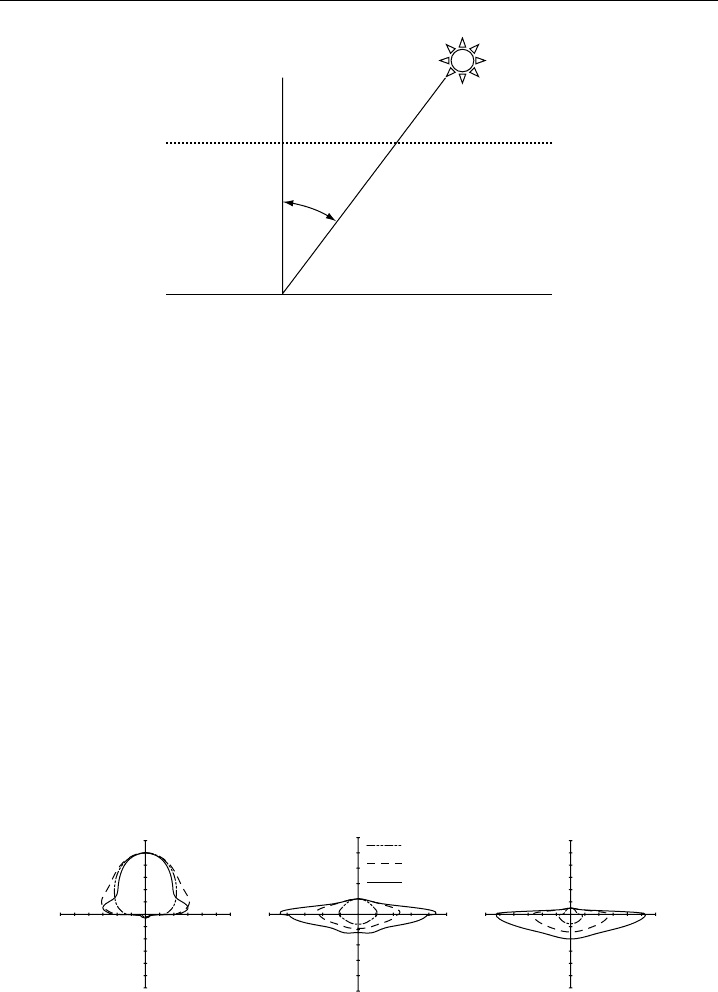Heard D.E. (editor) Analytical Techniques for Atmospheric Measurement
Подождите немного. Документ загружается.


408 Analytical Techniques for Atmospheric Measurement
−→ O
1
D +O
2
X
3
−
g
(R 9.5)
O
1
D is not only metastable but also highly reactive, and constitutes the main source of
atmospheric OH radicals by reaction with water vapour:
O
1
D +H
2
O −→ OH +OH (R 9.6)
OH is the principal atmospheric oxidant, which reacts with most trace gases and thus
prevents the accumulation of chemically reactive, toxic, or climatically active gases in the
atmosphere.
Reactions R 9.1–R 9.6 and the processes in Table 9.1 are the prime initiators and drivers
of atmospheric chemistry. Details of this chemistry can be found in many text books, for
example by Finlayson-Pitts and Pitts, Jr. (2000), Zellner (1999), or Seinfeld and Pandis
(1998).
9.1.2 Photolysis frequencies: Kinetic definition
A quantitative description of atmospheric chemistry is not possible without accurate
knowledge of the kinetic rates of the relevant photodissociation processes. Given the
general photolysis of some compound AB into its products A and B,
AB +h −→ A+B (R 9.7)
the following kinetic rate coefficient j can be defined:
j =−
1
AB
dAB
dt
(9.1)
Here, the square brackets denote the number density (cm
−3
) of the respective molecules
in the gas phase; and j is a first-order rate coefficient (s
−1
) that is called photolysis
frequency or j-value. In a given radiation field, it describes the probability per second of
the decomposition of the parent compound into its products. Note that j does not have
a constant value, but depends on the local radiation field which varies in space and time.
As for any first-order decay reaction, the reciprocal rate coefficient is the mean lifetime
of the decomposing molecules:
photolysis
=
1
j
(9.2)
If the j-value of a photolysis reaction is known, chemical loss and production rates can
be calculated. For the general reaction R9.7, it follows:
−
dAB
dt
=
dA
dt
=
dB
dt
= jAB (9.3)
Here, the product j ×AB is called the photolysis rate of AB. It is a measure of the
number of molecules of AB that decompose per cm
3
and per second, and produce a
corresponding number of photofragments A and B in the same volume and time.

Measurement of Photolysis Frequencies in the Atmosphere 409
9.1.3 Photolysis frequencies: Physical model
The probability of photoabsorption and photodissociation in the bulk gas phase is
independent of the direction of incident radiation, because the absorbing molecules are
randomly oriented in space. This is of particular importance in the atmosphere, where
molecules are exposed to radiation from many different directions. Any volume element
in the sunlit atmosphere can receive solar radiation either directly from the sun, or
indirectly after scattering by air molecules, aerosol particles and clouds in the atmosphere,
or after reflection by the ground (Figure 9.1).
All radiation passing through a volume element can be described by the spectral photon
radiance L
. This radiometric quantity is defined by the following equation (McCluney,
1994):
L
=
d
2
d dA cos
(9.4)
Here,
is the spectral photon flux (s
−1
nm
−1
), that is the number N of photons arriving
per time t in a small wavelength interval to +d,
=
d
2
N
dt d
=
dN
dt
(9.5)
that comes from the solid angle d (sr) along a direction
and passes through the
surface area dA (m
2
) of the volume at angle (Figure 9.2). The product dA cos
appearing in the denominator of Equation 9.4 represents the projected area, dA
of
the surface element d A onto a plane that is normal to
. Thus, the spectral radiance
L
s
−1
·m
−2
·sr
−1
·nm
−1
is the photon flux per unit projected area, per unit solid angle
and per unit wavelength interval passing through the surface of a volume element in a
specified direction.
Ground
Sun
Cloud
Air molecule
or particle
Air molecule
or particle
Volume-
element
Direct radiation
Figure 9.1 Volume element in the sunlit atmosphere which receives solar radiation either directly from
the sun, or indirectly after scattering by air molecules, aerosol particles and clouds in the atmosphere, or
after reflection by the ground.

410 Analytical Techniques for Atmospheric Measurement
dh
ds
n
dA' = dA cos
ϑ
Φ
λ
d ω
Ω
ϑ
ϕ
dA
Figure 9.2 Geometry of a volume element that is exposed to a flux of photons
from solid angle d
along direction
.dA and dh are the surface area and height of the volume element, respectively.
dA
is the projected area of dA onto a plane normal to
and ds is the absorption path length through
the volume.
n is the normal to dA. and are polar and azimuth angles, respectively.
The photoabsorption in the volume element follows Lambert–Beer’s law
dL
=−ABL
ds (9.6)
with being the bulk absorption cross section m
2
of AB, dL
represents the decrease of
the radiance inside the volume element along the absorption path length ds =d h/ cos ,
with dh being the height of the volume element dV =dA ×dh. Using Equations 9.4–9.6,
the decrease of L
per path length ds can be expressed as:
dL
ds
=
d
4
N
ddA cos dtdh/ cos
=
d
3
N
d dV dt
=−ABL
(9.7)
From this equation the spectral number of photons that are absorbed per unit volume
and per unit time can be derived as:
d
3
N
dV dt
=−ABL
d (9.8)
This equation applies to radiation incident from any single direction
. For radiation
incident from many different directions
, integration over all solid angles yields:
d
2
N
dV dt
=−AB
4sr
L
d (9.9)
The integral on the right-hand side of Equation 9.9 is called the spectral actinic flux F
(Madronich, 1987b):
F
=
4sr
L
d (9.10)
It represents the spectral flux of photons per unit area m
−2
·s
−1
·nm
−1
available to
molecules at a particular point in the atmosphere, irrespective of the directions from
where the photons arrive.

Measurement of Photolysis Frequencies in the Atmosphere 411
Assuming that upon absorption of a photon the probability of photodissociation is ,
the photolysis rate in the spectral interval to +d can be written as:
d
2
AB
dt d
=
d
2
N
dV dt
=−F
AB (9.11)
is called quantum yield of the photolysis reaction and is, like and F
, a wavelength-
dependent quantity. Furthermore, and can both depend on temperature. Integration
of Equation 9.11 over all wavelengths and comparison of the resulting equation with
Equation 9.3 then yields the following expression for the photolysis frequency of AB:
j =
T T F
d (9.12)
Note that the integration is to be performed over the wavelength range in which the
product F
is non-zero and therefore contributes to the j-value.
9.1.4 Actinic flux
Some comments on the terminology and meaning of actinic flux may be in place. The
actinic flux F
, as defined by Equation 9.10, is a quantitative measure of actinic radiation
in the atmosphere. The term actinic generally refers to radiation capable of causing
photochemical reactions. The term actinic flux is not quite exact in the sense that F
actually denotes an area density of flux. Actinic flux density would therefore be a more
appropriate name, but in fact the standard name in atmospheric-chemistry literature is
actinic flux and will be used accordingly in this chapter.
From a chemical kinetic point of view, F
can be interpreted as a measure of the
spectral photon number-density h
=dN
/dV , with F
=c×h
.IfF
is substituted
by h
, the expression for the spectral photolyis rate (Equation 9.11) assumes the form
of a rate equation of a bimolecular chemical reaction:
d
2
AB
dt d
=−kh
AB (9.13)
Here, by analogy, the photons in the wavelength interval to +d represent the
collision partners of AB and k =c× × can be understood as the effective rate constant
of the collision process.
9.1.5 Irradiance
The spectral actinic flux must be distinguished from another radiometric quantity that is
widely used in atmospheric physics and is called spectral irradiance:
E
=
2sr
L
cos d (9.14)

412 Analytical Techniques for Atmospheric Measurement
where E
is the hemispherically integrated radiance weighted by the cosine of the angle
of incidence and represents the photon flux per unit area through a plane surface. It
is fundamentally different from the actinic flux, which weights the incident radiation
uniformly (Equation 9.10), but has the same physical unit m
−2
·s
−1
·nm
−1
. Note that
energy-based quantities can be obtained from the photon-based quantities F
and E
by
multiplication with the corresponding photon energy, for example, E
e
= hc/ ×E
.In
this case, the relevant units are W ·m
−2
·nm
−1
.
9.1.6 Actinic flux in the atmosphere
Actinic flux in the atmosphere has a spatial and spectral distribution that is highly variable
and time dependent. It is mainly influenced by the position of the sun relative to the
point of observation, the state and chemical composition of the atmosphere, and the
spectral reflectance of the earth’s surface.
The actinic flux received at some point in the atmosphere consists of two components,
the direct solar radiation F
0
and the diffuse radiation F
diff
, which originates from scattering
in the atmosphere and at the earth’s ground (see Figure 9.1):
F
= F
0
+F
diff
(9.15)
F
0
represents the integrated, almost unidirectional radiance over the solid angle of the
solar disc and F
diff
denotes the integrated diffuse radiance over the solid angle of the
upper and lower hemisphere, excluding the solar disc. We can also write F
diff
as
F
diff
= F ↓ +F ↑ (9.16)
where F ↓ and F ↑ denote the downwelling and upwelling parts of the diffuse
radiation, respectively.
9.1.6.1 Direct solar radiation
A beam of direct solar radiation, which passes through the atmosphere (Figure 9.3), is
generally attenuated by absorption and scattering. The fraction that is transmitted
through a slant column of air along a path s can be calculated from Lambert–Beer’s law
and is given by
=exp−
s
i
i
h M
i
h d s (9.17)
where
i
is the wavelength-dependent cross section for absorption and scattering by
an atmospheric component M
i
. In general,
i
and the number density [M
i
] vary with
altitude h. The summation is performed over all relevant absorbers and scatterers and
the integral is calculated along the trajectory s. In the approximation of a non-refractive
plane-parallel atmosphere, the trajectory is a straight line in the direction of the sun
at solar zenith angle . When the zenith angle increases, the path length through the
atmosphere becomes larger with s ≈ h/cos , and less direct radiation is transmitted
according to Equation 9.17. Note that the approximation of a straight line holds only for
zenith angles that are not too large, <85
(Iqbal, 1983).

Measurement of Photolysis Frequencies in the Atmosphere 413
Sun
Atmosphere
h
Ground
Zenith
s
= h / cos (χ)
χ
Figure 9.3 Trajectory of direct solar radiation through a non-refractive plane-parallel atmosphere. The
solar zenith angle specifies the direction of the sun relative to the local vertical direction. h is the
height of a vertical air column above ground and s is the path length of the direct radiation through
the corresponding slant air column.
9.1.6.2 Diffuse radiation
Diffuse radiation which is scattered in the atmosphere returns partly into space, while
another part reaches the ground where it is absorbed or reflected. Diffuse radiation can
also be multiply scattered or absorbed by air components, which comprise gas molecules,
particles or cloud droplets. In general the relevance of atmospheric scattering processes
increases in air of increasing density or when the path length through the atmosphere
becomes longer at increasing solar zenith angle. Scattering becomes more important at
shorter wavelengths, according to
scatter
∝
−n
with n = 4 for gases (Rayleigh scattering)
and n ≈ 05–25 for aerosol particles (Mie scattering) that have diameters greater than
100 nm (Iqbal, 1983).
The angular distribution of the diffuse radiance varies with altitude and wavelength. An
example for cloud-free conditions is shown in Figure 9.4. At low altitude (0.1 km), most
of the diffuse radiation comes from the upper hemisphere. Little radiation returns from
0.1 km 6.1 km 12.2 km
(a) (b) (c)
300 nm
400 nm
330 nm
Figure 9.4 Polar diagrams of the relative angular distribution of diffuse radiance, modelled for a cloud-
free atmosphere over the Agean Sea in Greece (10 June, 1996, ∼ 20
, surface albedo 0.03). The
radiance data are azimuthally averaged and normalised to unity at the zenith. The data are shown for
wavelengths of 300, 330, and 400 nm at altitudes of (a) 0.1, (b) 6.1, and (c) 12.2 km (from Hofzumahaus
et al., 2002).

414 Analytical Techniques for Atmospheric Measurement
the ground, which, in this example, is assumed to have a small reflectivity. Contrary,
at an altitude of ∼12 km, the diffuse radiation comes predominantly from the lower
hemisphere, where in this case most of the backscattering air mass resides. At longer
wavelength (400 nm) a large portion of diffuse radiation comes from the horizon, whereas
at shorter wavelength (300 nm) the diffuse radiance is more uniformly distributed. In
a rough approximation, the diffuse sky radiance in the UV is often assumed to be
isotropically distributed in the lower troposphere. This subject has been discussed in
detail, for example, by Ruggaber et al. (1993).
Diffuse radiation is also contributed by reflections at the earth’s surface. The reflectance
(albedo) depends on the composition and structure of the ground, the angle of incidence
and wavelength of the radiation. In general, the reflectance of natural surfaces is rather
small in the UV and visible regions, typically less than 10% over vegetation or soil, but can
reach values close to one over fresh snow. Spectral albedo data for various ground covers
can be found, for example, in Iqbal (1983) or McKenzie and Kotkamp (1996). It should
be noted that these data are generally specified for solar irradiances. See Appendix A.1
how albedo data can be applied to actinic fluxes.
The partitioning of the actinic flux into direct and diffuse radiation varies with altitude,
solar zenith angle and wavelength. In the stratosphere the actinic flux is dominated by
direct radiation. Under conditions that favour scattering processes, the diffuse radiation
dominates. This is the case in the UV in the lower troposphere, where more than 50% of
the actinic flux is contributed by diffuse radiation. The diffuse fraction generally increases
with solar zenith angle and, quite naturally, assumes a value of one when the solar disc
is hidden, for example, by a thick cloud or a mountain.
9.1.6.3 Spectral composition
The wavelength dependence of absorption and scattering processes gives rise to significant
changes in the spectral composition of the solar radiation when it passes through the
atmosphere. Figure 9.5 shows the relevant cross sections of O
2
and O
3
, the two main
absorbers of solar UV radiation, and the Rayleigh-scattering cross section of air as a
function of wavelength. The absorption by O
2
and O
3
in the stratosphere has a strong
influence on the spectral actinic flux at wavelengths below 320 nm and prevents that any
solar radiation reaches the troposphere at <290nm (Figure 9.6). The sharp drop of
the actinic UV radiation between 290 and 320 nm by many orders of magnitude is called
the UV-B cut-off. It depends strongly on the vertical column density t of the absorbing
ozone in the atmosphere:
t
O
3
=
0
O
3
h d h (9.18)
Here t
O
3
is also called total ozone and is specified in Dobson units (DU), with 1 DU =
269×10
16
cm
−2
. It should be noted that particularly in polluted air, additional absorbers
and scatterers, like SO
2
and various kinds of aerosols (sulphate, black carbon, mineral
dust, droplets, etc.), can play a significant role for the spatial and spectral distribution of
the actinic flux in the atmosphere.
For further reading about the properties of actinic flux in the atmosphere, see, for
example, Demerjian et al. (1980), Madronich (1987b), Meier et al. (1997), Liao et al.
(1999), Mayer and Madronich (2004).

Measurement of Photolysis Frequencies in the Atmosphere 415
150 200 250 300 350
10
–26
10
–24
10
–22
10
–20
10
–18
Rayleigh scattering
Oxygen absorption
Ozone absorption
(× 0.001)
Cross section (cm
2
)
Wavelength (nm)
Figure 9.5 Cross sections for absorption of solar radiation by atmospheric oxygen and ozone, and for
Rayleigh scattering by air. Data are from Yoshino et al. (1992), Daumont et al. (1992), and Bates (1984),
respectively.
150 200 250 300 350 400
Wavelength (nm)
50 km
0
km
40
30
30
20
20
10
15
10
14
10
13
10
12
10
11
10
10
10
9
Actinic flux (ph cm
–2
s
–1
nm
–1
)
Figure 9.6 Spectral distribution of the solar actinic flux in the earth’s atmosphere at different altitudes.
The spectra are modelled for the US Standard Atmosphere at a solar zenith angle of 30
and for a ground
albedo of 0.3 (from DeMore et al., 1997, courtesy of NASA/JPL/CALTECH).

416 Analytical Techniques for Atmospheric Measurement
9.2 Methods for measuring photolysis frequencies
Measurements of actinic flux and photolysis frequencies have important applications in
atmospheric sciences. The first one is to provide observational data for field investigations
of atmospheric photochemistry. Here, photolysis frequencies are needed besides other
chemical and meteorological parameters for the understanding of observed chemical
changes in the atmosphere and the subsequent validation of atmospheric chemistry
models. The second application is to investigate how the actinic flux depends on the
chemical composition and the state of the atmosphere. Such process studies improve the
understanding of radiative transport through the atmosphere and help to interprete UV
climatologies and trends. The third application is the verification of radiative-transfer
models used for the prediction of photolysis frequencies and actinic fluxes in atmospheric
chemistry and physics.
9.2.1 Measurement requirements
In order to be useful, techniques for measuring photolysis frequencies must fulfil a
number of requirements:
•
They must cover the spectral range of wavelengths that contributes to the photolysis
processes of interest. For most photolysis reactions, this region includes wavelengths
of up to 420 nm (cf. Table 9.1). Only few atmospheric compounds photolyse at longer
wavelengths in the visible region and up to 640 nm and even more rare are loosely
bound compounds (e.g. O
3
and HNO
4
) that photodissociate in the near-infrared. At
short wavelengths, a lower limit is generally imposed by the available radiation. As
can be seen from Figure 9.6 this limit is around 290 nm in the lower stratosphere and
troposphere.
•
Given numerous photolysis reactions in the atmosphere, a technique should ideally
measure the photolysis frequencies of various chemical compounds with one instrument
at the same time.
•
The measurements must be sensitive to direct and diffuse radiation arriving from all
possible directions in the atmosphere, from the upper and lower hemisphere as well.
Ideally, the measurement should give equal weight to radiation from any angle of
incidence.
•
The measurements require a good temporal and spatial resolution, as the actinic flux
can be highly variable. This is particularly the case in situations with broken clouds.
Under such conditions light intensity can change over short distances and the local
actinic flux can vary in seconds.
•
In order to provide spatial coverage, a network of in situ measurement instruments
can be used. Alternatively, portable instruments can be mounted on mobile platforms
(e.g. aircraft or balloons) for measuring spatial distributions. In the latter case, it is
critical that the instruments have a small size and weight, and a low electrical power
consumption. No technique is so far available that would measure photolysis frequencies
remotely with extended spatial coverage.

Measurement of Photolysis Frequencies in the Atmosphere 417
9.2.2 General measurement methods
There exist two general methods for measuring atmospheric photolysis frequencies (cf.
Figure 9.7).
•
Chemical actinometry is a method that detects actinic fluxes directly by using the
chemical compound of interest. The relevant gas is exposed to solar radiation in a
static or flowing gas system and the rate of its photochemical conversion into products
is measured. The conversion rate is then used to evaluate a photolysis frequency
(Equation 9.1 or 9.3). Chemical actinometry is the most direct way to measure a
photolysis frequency and has the particular advantage that it does not require the
knowledge of the absorption cross section and quantum yield of the photolysis
reaction.
•
Radiometry is a general method for measuring radiation by optical instruments that
utilise photoelectric detectors. In atmospheric chemistry, radiometric methods have
been modified such that photolysis frequencies can be derived from the measured
intensity of the incident radiation.
Radiometry can be further grouped into methods that measure radiation
spectrally resolved (narrowband spectroradiometry) or spectrally integrated (broadband
radiometry) (cf. Figure 9.7). Each subgroup can be further divided into methods for
measuring actinic fluxes or irradiances. The result is a variety of different types of
radiometers that enable a more or less direct determination of photolysis frequencies
from measured radiation intensities.
•
Actinic-flux spectroradiometers provide the most direct way to derive photolysis
frequencies from measured radiation. They measure the actinic flux in narrow spectral
Methods for determination
of photolysis frequencies
Radiative transfer modelling
(numerical calculations)
Chemical actinometry
(chemical measurements)
Radiometry
(radiation measurements)
Static gas
actinometry
Flowing gas
actinometry
Spectroradiometry
(narrowband)
Filter radiometry
(broadband)
Actinic flux radiometry
(isotropic receiver)
Irradiance radiometry
(cosine receiver)
Figure 9.7 Methods for the determination of photolysis frequencies in the atmosphere.
